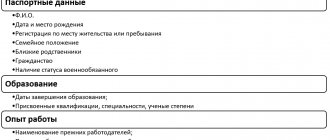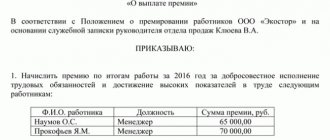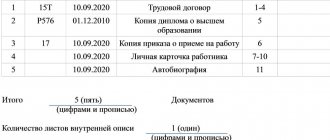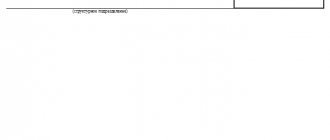An employee’s personal file is all his documents, collected in one place, and which relate to his work in a given organization or with a given individual entrepreneur (IP). An authorized employee of an organization or individual entrepreneur, for example, a personnel officer or accountant, must fill out an employee’s personal file if the organization or individual entrepreneur does not have a personnel department. A personal file is opened for an employee when he is hired. The task of the HR employee is not only to prepare documents for employees and store them, but also to protect the personal data of employees . Agreements must be signed with absolutely all employees that employees give permission to collect, store, and process their personal information. This agreement is also kept in your personal file. If there is no such permission, the organization or individual entrepreneur will be fined a large sum of money.
What documents are included in an employee’s personal file?
A complete list of documents that must be kept in an employee’s personal file exists only in government agencies. For commercial organizations or individual entrepreneurs that have employees, there is no such list, but they can take advantage of the requirements for government agencies in terms of personal files of employees. A personal file consists of a whole list of various documents. The recommended list of documents is as follows.
| p/p | Name |
| 1 | description of personal file |
| 2 | employee personal card |
| 3 | employee profiles |
| 4 | application for a job |
| 5 | employee resignation letter |
| 6 | employment contract and additional agreements thereto |
| 7 | the following types of orders: · The order of acceptance to work; · dismissal order; · order on incentives; · collection order; · transfer order; · other orders |
| 8 | reports and explanatory notes of the employee himself, as well as reports and explanatory notes in relation to this employee |
| 9 | copies of documents on the basis of which changes are made to personal data, the storage of which is permitted by law |
| 10 | work books |
| 11 | medical records, certificates of completed medical examination |
| 12 | characteristics, letters of recommendation from the employee’s previous places of work |
| 13 | various certificates, for example, certificates from previous places of work, certificates of no criminal record, etc. |
| 14 | copies of diplomas, certificates, certifications, advanced training, etc., if the availability of these documents is mandatory for occupying the corresponding position |
| 15 | autobiographies |
| 16 | copies of documents confirming disability or the degree of limitation of ability to work, if permitted by law |
| 17 | copies of documents permitting access to information constituting a state or other secret protected by law, if the presence of these documents is mandatory for occupying the corresponding position |
The following documents may also be stored in the employee’s personal file:
- employee job description;
- agreement on liability;
- non-disclosure agreement of trade secrets;
- employee consent to work with personalized data;
- other similar documents
Personal file of the employee, requirements for its registration
Existing legislation does not regulate the procedure for maintaining LD. Therefore, it is recommended to develop a regulation that will stipulate the details of the formation, maintenance and storage of this package of documents, its composition and the circle of persons who have access to it. The basis for this local regulatory act can be taken from the Decree of the President of the Russian Federation of May 30, 2005 No. 609 “On approval of the Regulations on the personal data of a state civil servant of the Russian Federation and the management of his personal file.”
Documents to be included in the LD can be divided into three categories:
- submitted and generated upon employment: copies of passport, SNILS, TIN, military ID, diploma, certificates, attestation;
- questionnaires and resumes;
- recommendations and characteristics from previous places of work;
- medical certificates;
- application for a job;
- employment contract;
- a copy of the employment order, etc.;
- job description;
- resignation letter;
What does an employee’s personal file consist of?
The personal file form is developed and approved by the organization itself or the individual entrepreneur personally . An organization or an individual entrepreneur may develop a local regulatory act, for example, a regulation on the management of personal affairs of employees. In this provision, you can describe everything related to the management of personal affairs, for example, what documents employees are required to provide to an organization or individual entrepreneur upon employment, what documents are drawn up by the organization or individual entrepreneur itself, as well as other issues on this topic. This local regulatory act is approved by order signed by the director. When forming this local regulatory act, you can be guided by the following legislative acts:
- chapters 10,11,12,13,14 of the Labor Code of the Russian Federation;
- Federal Law No. 152 of July 27, 2006 “On Personal Data”;
- “Basic Rules for the Operation of Organizational Archives” (approved by the decision of the Board of Rosarkhiv dated 02/06/02);
- Federal Law No. 125 of October 22, 2004 “On Archival Affairs in the Russian Federation”;
- Order of the Ministry of Culture of the Russian Federation No. 558 dated August 25, 2010 “On approval of the List of standard management archival documents generated in the course of the activities of state bodies, local governments and organizations, indicating storage periods”;
- Federal Law No. 79 of July 27, 2004;
- Federal Law No. 25 of 03/02/07;
- Decree of the President of the Russian Federation No. 640 of 01.06.98;
- Decree of the President of the Russian Federation No. 609 of May 30, 2005;
- other regulations
The formation of a personal file can be roughly divided into stages:
- filling out the title page;
- preparation of a certification sheet;
- filling out the internal inventory;
- file file
It is not recommended to create personal files longer than 250 pages. Personal files are usually stored in alphabetical order by divisions or branches of the organization, if any.
It is also very convenient to keep a log of employees' personal files. The log should contain the following information:
- employee personal file numbers;
- last names, first names, patronymics of employees;
- dates of transfer of personal files to the archive;
- dates of commencement of personal affairs;
- other necessary information
If an employee has any changes in his personal data, for example, his last name has changed, then he must notify the personnel service about this and provide documents confirming these changes.
Sample
As stated above, only authorized employees have access to make changes to personal files.
The heading for the personal file is your full name. employee. Variations in the spelling of the surname or the woman's maiden name may also be indicated. For example: Bread (Kalinina) Elena Maksimovna.
When registering a personal file, it is allowed to accept documents that are dated earlier than the date the employee was hired. This issue is considered in individual cases, but, as a rule, it is resolved in favor of the employee.
The complete case form includes the following items:
- Design and entry of data on the cover of the folder (cover design will be discussed later).
- It is important to record the number of sheets in the case (no more than 250 pages).
- Preparation of the certification sheet.
- Internal inventory of documents in accordance with the apparent quantity collected, data verification.
- File filing, case binding.
- Entering the necessary information into the cover of the employee’s personal file.
It is very important to know which documents are filed and which are not.
The case file includes only the most important and significant documents, which can be stored for up to 75 years. If there are documents about the beginning of vacation, applications for vacation at your own expense, and the like, then these documents are not included in the filing folder. They are added to the total quantity.
How to fill out an employee's personal file
Typically, a cover page provides as much information as possible about the employee in order to make it easier to find the required information. The cover page of a personal file may look like this.
| Title page section title | How to fill out |
| Name of the organization | The name of the organization is indicated; if the organization has divisions or branches, then the name of the division or branch in which the employee works is indicated |
| Serial number | In order to avoid confusion in personnel work, it is necessary to number personal files |
| Full name of the employee | Simplifies the search for an employee’s personal file by HR or accounting department employees |
| Date of opening of personal file | The date of opening a personal file usually coincides with the date of the employment order |
| Date of closing of personal file | The date of closure of the personal file must coincide with the date of the order to dismiss the employee |
| Number of sheets in personal file | This information is filled out before submitting documents to the archives. |
A certification sheet is needed to note the numbering of documents in the file, the physical condition of the sheets, the specifics of filling out individual forms, etc. The certification sheet states:
- letter numbers of sheets;
- envelopes with attached attachments in them;
- damaged sheets;
- sheets with photographs;
- missing pagination
The internal inventory consists of the following sections.
| Title of the title section of the internal inventory | How to fill out |
| Personal document number | The number is indicated here in order |
| Full name of the employee | The employee's last name, first name and patronymic must be indicated. |
| Serial number | The serial number of the entry in the inventory is indicated |
| Document index | The document index is indicated if available |
| Document title, summary | This section indicates which document is included in the inventory; for example, the entry may look like “Job Application” |
| Case sheet numbers | This indicates under what numbers the specified documents are stored in the personal file. |
| Date of inclusion of the document in the personal file | The date when the document was included in the personal file is indicated |
| Note | Section for any additional information |
| Number of documents in words | At the end of the inventory, the number of documents contained in this inventory is indicated in numbers and in words. |
| Number of internal inventory sheets | The number of pages in the inventory is indicated here |
| Responsible officer | The signature of the authorized employee, the transcript of the signature, the date are affixed |
Inventory of personal matters
Personnel records must be organized in each institution. An inventory of personal files for personnel will also have to be compiled when transferring documentation to the archives department. This list must contain the following details:
- name of the institution or its structural divisions;
- numbers of funds and case indexes;
- documentation headers;
- dates of their compilation;
- number of pages in the case;
- additional notes.
Register personal files in the OD in chronological order. If during the census a case was identified that should have been indicated earlier, then it is permissible to make an entry with the letter, for example, 100/a, but it will have to be registered at the very end of the document.
At the bottom of the OA, summary records should be recorded that reflect the total number of cases, as well as the number of the first and last case. Then the information is endorsed by the head of the organization (structural unit), the responsible executive, as well as the head of the archives department. Provide information about the responsible persons in the following format: position, signature, full name. and date.
Storage periods for personal files
Since the personal files of employees contain confidential information in the form of personal data of employees, personal files must be stored in safes or a special cabinet, which must be locked with a key. Only authorized employees may have access to such information. Such employees are approved by order of the organization or individual entrepreneur signed by the director. If an employee quits, his personal file can be kept in the organization for 3 years after that. After this period, his personal file is transferred to the archive and stored there. All personal files that are not used in work are stored in the archive. If a personal file was created after 2003, then its storage period is 50 years, and if before 2003, then 75 years, and the personal files of senior employees are stored indefinitely. The retention period begins to count from the moment the file is transferred to the archive. If a personal file includes documents with different retention periods, then the entire personal file is stored for the maximum period.
Personal files can be stored, for example:
- by serial numbers;
- by last name, first name, patronymic of employees (alphabetically);
- by personnel numbers of employees;
- by branches, divisions;
- by dates of opening of personal files;
- in other ways
How is it carried out?
All personal files of the enterprise are displayed in a special notebook or journal, where they are provided with a special number at the place of work. This journal contains brief information about the case: Full name. employee, date of transfer to the archive, start date of the case, number.
It is a mistaken belief that any HR department employee has access to employees’ personal files. This is not true, all power and ability to make changes is exercised by the authorized person. Changes may be the following: documents from the registry office, name change and others.
In this case, copies of documents confirming the facts are entered into the personal file.
Proper storage of personal files is very important, because this is confidential information to which a limited number of people have access.
Storage periods for personal files:
- personal files of employees are kept for up to 75 days;
- personal files of senior positions can be stored for an unlimited amount of time;
The retention period begins from the moment the file is transferred to the archive.
How to fill out an employee application form
In many organizations or individual entrepreneurs, during interviews, employees are asked to fill out a questionnaire. The questionnaire is designed to give employers an idea of the employee’s qualifications, education, work experience, etc. The application form is usually accompanied by a photograph of the employee. The questionnaire usually contains the following questions:
- about education;
- about human interests;
- about work experience;
- about previous places of work;
- about marital status;
- about the presence or absence of children;
- questions about a person’s gender and age;
- about bad habits;
- about the absence of any diseases (for certain types of work);
- about qualifications;
- about professional skills;
- about professional achievements;
- other information
Common personal file mistakes
Error 1. You can store copies of any documents in an employee’s personal file.
How right. Not all documents can be stored in the employee’s personal file. You cannot store documents that are not related to the performance of official duties in your personal file. Documents that are safe to keep in your personal file are:
- employment contract;
- orders;
- questionnaires;
- work book;
- other documents permitted by law (see table at the beginning of the article)
It is not safe to keep copies of the following documents in your personal file:
- TIN;
- SNILS;
- passports;
- military ID;
- marriage certificates;
- birth certificates of children, etc.
Moreover, you can request such documents when registering an employee, but you cannot store them. Roskomnadzor insists on this. This position is also shared by judges, this is particularly stated in the Resolution of the Kirov Judicial District of the city of Astrakhan in case No. 5-244/2012 dated 05.24.12 and in the Resolution of the Arbitration Court of the North Caucasus District in case No. A53-13327/2013 dated 21.04 .14.
For violation of these rules, an administrative fine is provided, which can reach up to 50,000 rubles. This is stated in Part 1 of Article 13.11 of the Administrative Code. An organization or individual entrepreneur with employees may be given a warning, but if they do not respond and correct the situation, they may face the following fines.
| Who will be subject to an administrative fine? | Amount of fine, in rubles |
| For an individual | 1 000 – 3 000 |
| For an official | 5 000 – 10 000 |
| For a legal entity | 30 000 – 50 000 |
Common questions related to personal matters
Question. Is it possible to give personal files to employees?
Answer. According to the law, personal files cannot be issued to employees. The only thing an employee can do is get acquainted with all the documents that are filed in his personal file in the presence of a specialist. If personal files are stored in a special room, then you can only get acquainted with your personal files there. The specialist must record the fact of the employee’s request. During the period of familiarization with the personal file, it is prohibited to remove documents included in the personal file from the premises, make any notes, or correct anything. All changes are made only by an employee of the organization who is authorized to do so. After the employee has reviewed the personal file, the employee responsible for storing personal files must make sure that all documents are in place and in their original form.
Important! If an employee leaves an organization or an individual entrepreneur, then he is not given a personal file. It will be archived.









